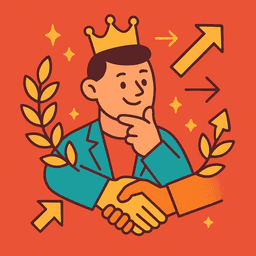LIE (ENTj) – Logical-Intuitive Extrovert (The Strategist) Personality Type
Efficient and future‑focused, LIEs optimize systems, chase leverage, and scale ideas into results.
LIE (ENTj) personality type profile explores traits, strengths, weaknesses, compatibility, and career suggestions based on Socionics theory.

Core Traits
- Outcome-driven
- Analytical leader
- Opportunity seeker
- Systems optimizer
Strengths
Leverage mapping LIEs identify economic levers, design scalable operating models, and keep teams aligned to measurable outcomes.
Prioritization They prune distractions quickly and communicate trade‑offs candidly.
Execution at scale Systems thinking helps them turn prototypes into durable engines.
About LIE
LIE (ENTj) — The Strategist in Socionics. This profile covers traits, strengths and weaknesses, relationships, work, compatibility, and growth tips.
The LIE (ENTj) — The Strategist — profile describes a repeatable attention pattern from Socionics, translated here into plain language. Rather than boxing people in, this description explains what tends to energize the type, where effort drains away, and how others commonly experience them. The goal is practical self-knowledge: use your strengths on purpose, protect your weak spots with small guardrails, and choose environments that make your best behavior easy and your worst behavior harder. You’ll find a blend of theory (information elements / Model A) and everyday behaviors. For each section we connect abstract ideas to concrete examples—how this type communicates under pressure, what work rhythms fit, why some collaborations feel effortless and others frictional, and which habits compound over time.
Origins & Theory
Socionics grew from Aushra Augustinavichiute’s work in the late 20th century, integrating Jung’s typology with an information‑metabolism model. It distinguishes between information elements (such as ethics/logic, intuition/sensing) and their roles in a type’s functional stack (base, creative, role, vulnerable, etc.). Our summaries keep the core structure but use contemporary, behavior‑first language so newcomers can apply insights without jargon. Read type not as destiny but as a stable bias in attention and decision-making.
Relationships & Love
LIE (The Strategist) types seek relationships that honor their natural pace and priorities. When partners communicate needs plainly and respect differences in energy or decision style, the best traits of this type flourish—patience, insight, loyalty, or drive—while typical friction points shrink.
In romance, align on expectations early: how you express care, how you handle conflict, and how decisions get made. Shared rituals (weekly check‑ins, device‑free time, a default plan for tough days) turn small misunderstandings into quick repairs.
Friendships deepen around recurring activities that fit the type’s cadence—anything from quiet evenings to lively projects. Directness plus kindness beats passive signaling; assume good intent and verify with questions.
In families, this type contributes in predictable ways—organizing logistics, setting a calm tone, telling the story, or solving the hard problem. Celebrate that contribution openly and trade roles intentionally so no one gets stuck carrying invisible labor.
Work & Career
At work, LIE (The Strategist) types thrive when their day matches their strengths. Give them clear outcomes, honest constraints, and the freedom to approach problems in their natural sequence.
Look for roles that reward their strengths list; pair them with partners who cover blind spots. Environments that prize psychological safety and crisp feedback loops let them learn faster.
When leading, they scale what they already do well—clarity, momentum, or care—while delegating duties that fight their wiring. A reliable second-in-command with complementary bias keeps decisions balanced.
On teams, expect them to gravitate toward tasks matching their strengths: generating options, building structures, stabilizing morale, driving execution, forecasting risk, or refining tools.
Deep Dive
LIE is not a stereotype. Quiet LIEs can be bold under pressure; assertive LIEs can be reflective and gentle. Type describes where attention goes first—not maturity, intelligence, or goodness. People flex across contexts and grow with practice.
Growth for this type is mostly about small, repeatable adjustments rather than personality overhauls. Treat friction as a signal to change the environment or the sequence, not proof of personal defect. Practical starting points include: - Name three recurring failure loops and design one 5‑minute guardrail for each. - Time‑box analysis or execution sprints to avoid over‑ or under‑thinking. - Pair deliberately with a complementary partner and write down the contract. - Schedule recovery the way you schedule effort; protect sleep and movement. - Replace vague intentions with visible checklists and clear owners.
Popular media leans on archetypes, which can be helpful shorthand but rarely map cleanly to a single type. Use characters as starting hypotheses, not proof. Real people are more complex and context‑sensitive.
Weaknesses
Blind spot costs LIE (The Strategist) types can lean so hard into their strengths that maintenance work, interpersonal nuance, or long‑range trade‑offs get underweighted.
Typical failure loop Under stress they double‑down on defaults—more analysis, more speed, more comfort‑seeking, or more persuasion—when the moment actually demands the opposite.
Countermeasures that work Pair with complementary partners, time‑box decisions, and agree to explicit acceptance criteria so quality and delivery stay balanced.
Best Compatibility
Note: Compatibility is a guide, not a rule. Individual maturity and context matter.
Career Suggestions
Roles that reward the strengths listed above • Environments with clear outcomes and honest constraints • Teams that value complementary partnership
Related Types



